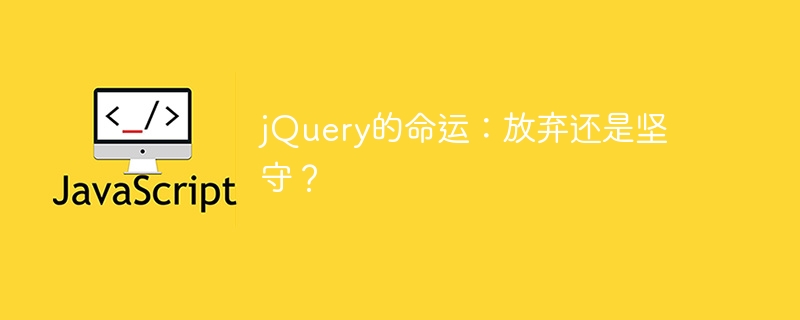Home >Web Front-end >JS Tutorial >To choose or not to choose: jQuery's destiny?
To choose or not to choose: jQuery's destiny?
- PHPzOriginal
- 2024-02-24 10:18:081133browse

jQuery is a controversial front-end library. For a period of time, it has been widely regarded as one of the most practical and popular tools in web development, and countless developers rely on it to simplify DOM operations, handle events, implement animation effects, etc. However, with the rapid development of modern Web technology, jQuery's status seems to be beginning to waver. More and more people are beginning to question whether jQuery is still necessary and competitive in today's front-end development field. So, is jQuery’s fate to give up or stick to it?
The rise of jQuery can be traced back to 2006. At that time, web development was full of compatibility issues between different browsers, DOM operations were cumbersome and complicated, and JavaScript language standards had not yet been unified. However, the emergence of jQuery solved the problem very well. these questions. It simplifies common tasks such as DOM operations, event processing, animation effects, etc., greatly improves development efficiency, and has become the tool of choice for many developers. At the time, jQuery was indeed a revolutionary product that injected infinite vitality into front-end development.
However, the times are constantly advancing, and front-end technology is also developing rapidly. The popularity of HTML5 and CSS3, the improvement of modern browser performance, and the rise of front-end frameworks such as React and Vue have all brought challenges to traditional jQuery. In comparison, these new technologies are more flexible and efficient, and have integrated many jQuery functions themselves. Under this situation, more and more developers are beginning to wonder whether it is still necessary to continue using jQuery, and perhaps it can be eliminated.
Of course, jQuery is not without its merits. In some specific scenarios, especially in the maintenance and upgrade of traditional websites and applications, jQuery still has certain advantages. After all, its compatibility is very good and can run on almost all modern browsers, and for some simple page interaction effects, using jQuery can be simpler and faster. In addition, due to its large ecosystem and rich plug-in support, jQuery is still a reliable choice in some specific cases.
So, for developers, should they continue to stick to jQuery, or should they abandon it and switch to more modern technologies? In fact, this is not a black and white issue. In actual development, different projects and different needs may have different answers. Sometimes, abandoning jQuery and adopting more modern technologies can indeed improve development efficiency and performance; and sometimes, for old projects or simple functions, sticking to jQuery may not be a wrong choice.
Ultimately, how to view the fate of jQuery depends on the understanding and choices of developers. Whether you continue to stick to it or choose to give up, you should find the direction that best suits you through continuous learning and practice. For a once-great tool like jQuery, perhaps the most important thing is to respect its history, development, and its contributions to front-end development. Giving up and persevering are both attitudes, and the key lies in how we understand and apply it. Hopefully the fate of jQuery will teach us some insights about the evolution of technology.
The above is the detailed content of To choose or not to choose: jQuery's destiny?. For more information, please follow other related articles on the PHP Chinese website!

